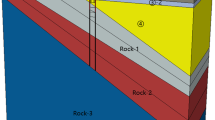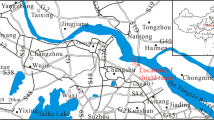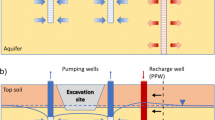Abstract
Slurry walls are non-structural barriers that are constructed underground to impede groundwater flow or manage groundwater control problems. The study area is in the Piemonte plain (Italy), close to the River Po. Quarrying works carried out below the piezometric surface created two big quarry lakes. The local groundwater system is characterized by a lower semi-confined aquifer, which is overlain by a semi-permeable bed of clayey peat (aquitard) and an upper unconfined aquifer. Locally, the peat fades away and the granulometry of this horizon becomes silty sandy. A planned enlargement of the quarry will increase the size and depth of the quarry lakes. So the aquitard bed between the two aquifers will be damaged, creating a mixing rate of groundwater. Such a procedure would not be compatible with the presence of two municipal wells upstream from the quarries. Consequently, the installation of a vertical diaphragm (slurry wall) is recommended to separate the aquifers and to act as a filter for the groundwater flowing from the unconfined to the semi-confined aquifer. To predict the consequences caused by the installation of the vertical diaphragm separating the unconfined aquifer and the semi-confined one, a specifically adjusted finite-difference model was used. The model showed a maximum rising of the water table equal to 12 cm, just upstream of the diaphragm and for a distance of about 100 m, and a maximum lowering of 2 cm just downstream of the diaphragm. However, the slurry wall would not cause any change in the piezometric head in the area where there are municipal wells and, hence, will not have any negative effect on the functionality of the municipal wells. Moreover, the migration of water from the unconfined aquifer through the vertical diaphragm will stimulate a series of attenuation and auto-depuration processes of eventual contaminants. These processes are due to the higher crossing time that the groundwater flow takes to go through the vertical barrier (t a = 96.5 days, whereas for the horizontal semi-permeable layer t a = 9.6 days). So, the vertical diaphragm can be a resolutive element, representing a mediation and separation factor between the unconfined and the semi-confined aquifers along the border of the quarrying areas, and a protective barrier for the water quality of the quarry lake and the semi-confined aquifer.

















Similar content being viewed by others
References
Bortolami G, De Luca DA, Filippini G (1990) Caratteristiche geolitologiche e geoidrologiche della pianura torinese “Geological and hydrogeological features of Torino plain”. In: Le acque sotterranee della pianura di Torino: aspetti e problemi. Provincia di Torino, Assessorato all’ecologia, M/S Lit.: 9–16
Bortolami G, De Luca DA, Masciocco L, Morelli di Popolo e Ticineto A (2000) La cartografia tematica nella pianificazione territoriale: la carta della vulnerabilità della falda idrica superficiale nel territorio della Provincia di Torino “Thematic cartography in territorial pianification: the vulnerability map of surface aquifer in Torino Province”. Geologia dell’Ambiente 1:25–30
Bortolami G, De Luca DA, Masciocco L, Morelli di Popolo e Ticineto A (2002) Le acque sotterranee della pianura di Torino: carta della base dell’acquifero superficiale “Groundwater of Torino plain: map of surface aquifer bed”. Assessorato Risorse idriche e atmosferiche, Prov. Torino, Lit. Savigliano, 32pp
Bove A, Casaccio D, Destefanis E, De Luca DA, Lasagna M, Masciocco L, Ossella L, Tonussi M (2005a) Assetto geoidrologico della Regione Piemonte “Hydrogeological sketch of Piemonte”. Idrogeologia della pianura piemontese, Regione Piemonte, Mariogros Industrie Grafiche S.p.A., Torino, 17pp
Bove A, Casaccio D, Destefanis E, De Luca DA, Lasagna M, Masciocco L, Ossella L, Tonussi M (2005b) Piezometria della falda superficiale nel territorio di pianura della Regione Piemonte “Potentiometric surface map of Piemonte plain”. Idrogeologia della pianura piemontese, Regione Piemonte, Mariogros Industrie Grafiche S.p.A., Torino, 10pp
Charrier G, Peretti L (1975) Analisi palinologica e datazione radiometrica 14C di depositi torbosi intermorenici della regione alpina piemontese, applicate allo studio del clima e dell’ambiente durante il Quaternario superiore “Palynological analyses and radiometric 14C dating of peat in morainic deposits of Piedmont Alpine region applied to the study of climate and natural environment during upper Quaternary”. Boll Comit Glac It 23:51–56
Charrier G, Peretti L (1977) Ricerche sull’evoluzione del clima e dell’ambiente durante il quaternario nel settore delle Alpi Occidentali Italiane “Quaternary evolution of climate and environment in the Italian Western Alps”. Boll Ist ed Orto Bot Univ Torino 22:157–192
Gautero L (1998) Simulazione mediante modello matematico delle operazioni di lagunaggio in Comune di La Loggia (TO) “Mathematical simulation of lagoonal in La Loggia Municipality (Torino)”. GEAM marzo 1:61–67
Lucchesi S (2001) Sintesi preliminare dei dati di sottosuolo della pianura piemontese centrale “Preliminary summary of subsoil features in central Piemonte plain”. GEAM 28(2–3):115–121
McDonald MG, Harbaugh AW (1988) A modular three-dimensional finite-difference groundwater flow model. Scientific Software Group, Book 6, WA, USA
Tropeano D, Cerchio E (1984) L’orizzonte torboso wurmiano nel sottosuolo della pianura piemontese meridionale. Osservazioni preliminari “Wurmian level of peat in subsoil of southern Piemonte plain”. Boll Associazione Mineraria Subalpina 3:199–221
Author information
Authors and Affiliations
Corresponding author
Rights and permissions
About this article
Cite this article
De Luca, D.A., Lasagna, M. & Morelli di Popolo e Ticineto, A. Installation of a vertical slurry wall around an Italian quarry lake: complications arising and simulation of the effects on groundwater flow. Environ Geol 53, 177–189 (2007). https://doi.org/10.1007/s00254-006-0632-3
Received:
Accepted:
Published:
Issue Date:
DOI: https://doi.org/10.1007/s00254-006-0632-3




